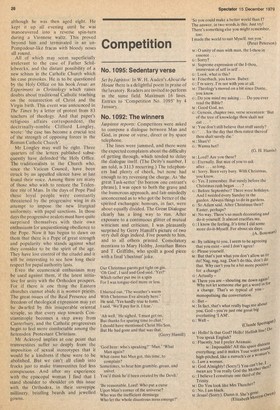Jewelled gowns
Patrick Marnham
It was while sitting in a pew at an Anglican wedding, brooding about the appearance of the choir, that I became aware of the connection between the two major events of last week — the transvestite murder case and the investigation by the Holy Office into the theological views of Father Professor Edward Schillebeeckx.
For among those in the choir stalls at this joyful religious ceremony there was a reincarnation of the late Archbishop of Armagh, St Oliver Plunkett. More careful scrutiny revealed that this was actually a handsome female choir-person whose hair was arranged in the manner of a 17th'century full-bottomed wig. Her red cassock and white surplice completed the illusion. She would certainly have qualified for inclusion in Peter Ackroyd's comprehensive new study of transvestism, Dressing Up (Thames and Hudson £4.95).
Mr Ackroyd's book, which I am still in the process of reading, takes the widest possible view of its subject. It includes the most pathetic cases of perversion as well as photographs of Sir Alec Guinness and Lord Olivier dressed for female rotes. And though it might seem rather hard to suggest that a woman wearing shoulderlength hair and an ankle-length red skirt should appear in a work on transvestism, such is the persuasiveness of Mr Ackroyd's analysis that I felt the authentic thrill of horror which he suggests transvestism causes when, some way into the second hymn, I realised my mistake about St Oliver.
Mrs Chapman, who is now serving a life sentence for the murder of her transvestite husband, would doubtless be able to describe this horror even better than does Mr Ackroyd. Other women in a similar position have been more compassionate and have even bought their husbands' female clothes and helped them to dress. Apart from female judges and barristers, the only two transvestites I have met (as far as I know) are a brave and attractive girl who penetrated the forbidden areas of Qom to interview Islamic teachers, and a young man who once told me that he wore female dress to burglarise his own office, If caught, he intended to kick off his heels, hitch up his dress and run like hell. But, since I met both in conventional attire, their shock value remained untested.
There was also De La Force I who, in 1954, attended the annual fancy dress ball of All Hallows School for Boys in an elaborate Mme de Pompadour outfit. This Illusion was all the more remarkable since, with the aid of face powder and stick-on beauty moles, he appeared to be about 85, although he was then aged eight. He kept it up all evening until he was manoeuvered into a reverse spin-turn during a Viennese waltz. This proved beyond him and terminated in an unPompadour-like fracas with bloody noses all round.
All of which may seem superficially irrelevant to the case of Father Schillebeeckx, and the distant possibility of a new schism in the Catholic Church which his case provokes. He is to be questioned by the Holy Office on his book Jesus: an Experiment in Christ°logy which raises doubts about traditional Catholic teaching on the resurrection of Christ and the Virgin birth. This event was announced in The Times by a letter of protest from 83 teachers of theology. And that paper's religious affairs correspondent, the doctrinally-nimble Clifford Longley, wrote: 'the case has become a crucial test of the strength of opposing forces in the Roman Catholic Church'.
Mr Langley may well be right. Three quarters of the letters published subse quently have defended the Holy Office.
The traditionalists in the Church who, since the Vatican Council, have been struck by an appalled silence have at last found their voice. Among them are many of those who wish to restore the Triden tine rite of Mass. In the days of Pope Paul these loyal people were constantly threatened by the progressive wing in its attempt to impose the new liturgical uniformity, with papal sanctions. In those days the progressive zealots must have quite surprised themselves with their own enthusiasm for unquestioning obedience to the Pope. Now it has begun to dawn on them that there is a Pope of great strength and popularity who stands against what they consider to be the spirit of the age.
They have lost control of the citadel and it will be interesting to see how long their respect for papal authority lasts.
Even the ecumenical enthusiasm may be used against them, if the latest initia tive for unity with the Orthodox prospers.
For if there is one thing the Eastern churches cannot abide it is women priests.
The great issues of the Real Presence and freedom of theological expression may yet be dwarfed by this insuperable oriental scruple, so that every step towards Constantinople becomes a step away from Canterbury, and the Catholic progressives begin to feel more comfortable among the heterodox Protestant Christians.
Mr Ackroyd implies at one point that transvestites suffer so deeply from the imposition of sexual stereotypes that it would be a kindness if these were to be abolished. But we can't all climb into frocks just to make transvestites feel less conspicuous. And after my experience with the episcopal woman I find that I stand shoulder to shoulder on this issue with the Orthodox, in their stovepipe millinery, bristling beards and jewelled gowns.



































 Previous page
Previous page